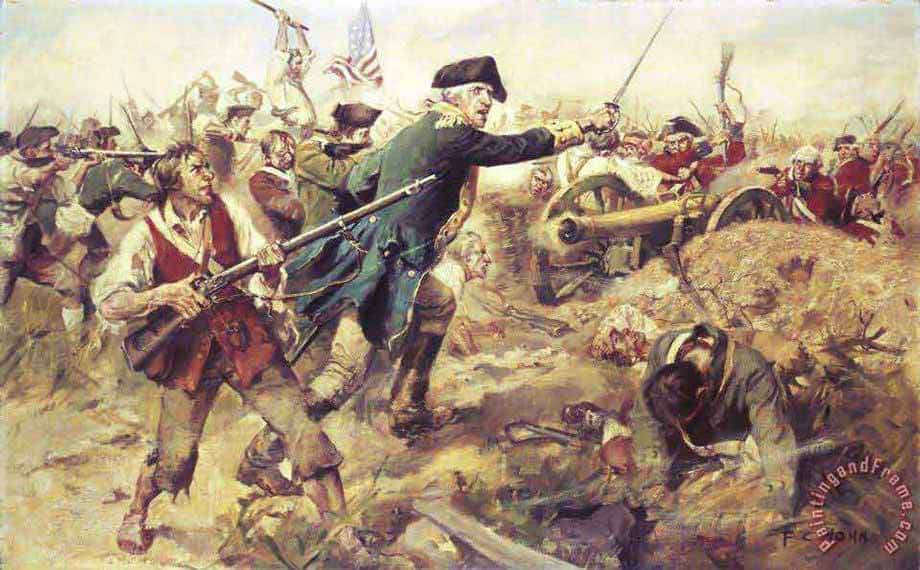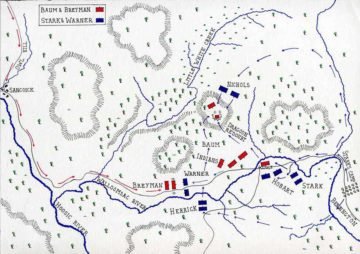The Battle of Bennington
August 16 , 1777 at Bennington, Vermont

Battle Summary
The Battle of Bennington took place in Walloomsac, New York, about 10 miles from its namesake Bennington, Vermont. The American force was primarily composed of New Hampshire and Massachusetts militiamen and reinforced by Vermont militiamen led by Colonel Seth Warner and members of the Green Mountain Boys. They decisively defeated a detachment of Lieutenant General John Burgoyne's army, led by Lieutenant Colonel Friedrich Baum, and supported by additional men under Lieutenant Colonel Heinrich von Breymann.
Baum's detachment was a mixed force of 700 composed primarily of Hessians but also including small amounts of dismounted Brunswick dragoons, Canadians, Loyalists, and Indians. He was sent by Burgoyne to raid Bennington in the disputed New Hampshire Grants area for horses, draft animals, provisions, and other supplies. Believing the town to be only lightly defended, Burgoyne and Baum were unaware that Stark and 1,500 militiamen were stationed there.
After a rain-caused standoff, Brigadier General John Stark's men enveloped Baum's position, taking many prisoners, and killing Baum. Reinforcements for both sides arrived as Stark and his men were mopping up, and the battle restarted, with Warner and Stark driving away Breymann's reinforcements with heavy casualties.
The battle reduced Burgoyne's army in size by almost 1,000 troops, led his Indian support to largely abandon him, and deprived him of much-needed supplies, such as mounts for his cavalry regiments, draft animals and provisions; all factors that contributed to Burgoyne's eventual defeat at the Battle of Saratoga.
Facts about the Battle of Bennington
- Armies - American Forces was commanded by Brig. Gen. John Stark and consisted of about 2,350 Soldiers. British Forces was commanded by Lt. Gen. John Burgoyne and consisted of about 1,350 Soldiers.
- Casualties - American casualties were estimated to be 30 killed and 40 wounded. British casualties was approximately 207 killed or wounded and 700 captured.
- Outcome - The result of the battle was an American victory. The battle was part of the Saratoga Campaign 1777.
Prelude
Burgoyne was attempting to push through the northern Hudson River Valley. After the recent British victories at Hubbardton, Fort Ticonderoga, and St. Clair, his plan was to defeat the American forces in the area and then continue south to Albany and onto the Hudson River Valley, dividing the American colonies in half. This was part of a grand plan to divide the rebellious New England colonies from the (believed) more loyal remaining colonies via a three-way pincer movement.
However, the western pincer was repulsed at Oriskany, and the southern pincer, which was to progress up the Hudson valley from New York City, never started since General William Howe decided to attack Philadelphia instead of helping Burgoyne.
By late July, Burgoyne's progress towards Albany had slowed to a crawl and his army's supplies began to dwindle. Burgoyne sent a detachment of about 800 troops under the command of the Baum from Fort Miller. Half of Baum's detachment was made up of dismounted Brunswick dragoons of the Prinz Ludwig regiment, while the other half consisted of local Loyalists, Canadians, and Native Americans. Baum was ordered to raid the supply depot at Bennington, which believed to be guarded by fewer than 400 American militia.

Battle of Bennington
Burgoyne's supply lines from Canada were growing longer and less secure. His German mercenaries, mostly Brunswickers, did not have any cavalry horses and his army was short of beef, wagons, and draft animals. With little regard for the American's military skills, he proposed that Baum lead an expedition into Vermont and New Hampshire to forage for supplies.
Hearing that the American storehouses at Bennington were poorly defended, Burgoyne ordered instead that Baum capture them. Half of Baum's troops were Brunswickers; the remainder were Canadians, British sharpshooters, Tories and Indians.
The intelligence Burgoyne had received was inaccurate. Vermont's Council of Safety, aware of his approach, had sent out a call for help. When information arrived that Major General Authur St. Clair had retreated and Ticonderoga had been taken, New Hampshire flew to arms, and called for Stark to command her troops. He consented on condition that he should not be subject to any orders but his own; and to this the council of state agreed, because the men would not march without him.
Setting out with a small force of 1,500 men for Bennington, Stark learned that Burgoyne had dispatched Baum with 500 men to seize the stores collected at that place. Sending out expresses to call in the militia of the neighborhood, Stark marched out to meet him, hearing of which, Baum entrenched himself in a strong position about 6 miles from Bennington, and sent to Burgoyne for re-enforcements. Stark's men and a smaller force of Vermont militia under Col. Seth Warner were near Bennington as Baum's expedition was preparing to attack.
On August 11, Baum set out on the 40-mile trek to Bennington, but the unmounted cavalrymen in their cumbersome uniforms, plus his strict adherence to European military formalities, slowed the march.
On August 13, en route to Bennington, Baum learned of the arrival in the area of 1,500 New Hampshire militiamen under the command of Stark. Baum ordered his forces to stop at the Walloomsac River, about four miles west of Bennington. After sending a request for reinforcements to Fort Miller, Baum took advantage of the terrain and deployed his forces on the high ground. In the rain, Baum's men constructed a small redoubt at the crest of the hill and hoped that the weather would prevent the Americans from attacking before reinforcements arrived. Deployed a few miles away, Stark decided to reconnoiter Baum's positions and wait until the weather cleared.
On August 14, the American raiders met and drove off a British scouting party at Sancoicks Mills. After dispatching a request for reinforcements, Baum advanced 4 miles to a hill overlooking the Walloomsac River. Only five miles from Bennington, Baum's men entrenched on and around this hill, awaiting further American resistance.
Battle Begins
On the afternoon of August 16, the weather cleared, and Stark ordered his men to be ready to attack. He is reputed to have rallied his troops by saying they were here to fight for their "natural born rights as Englishmen" and "There are your enemies, the Red Coats and the Tories. They are ours, or this night Molly Stark sleeps a widow."
Upon hearing that the militia had melted away into the woods, Baum assumed that the Americans were retreating or redeploying. However, Stark had decided to capitalize on weaknesses in the German's widely distributed position, and had sent sizable flanking parties to either side of his lines. These movements were assisted by a ruse employed by Stark's men that enabled them to get closer safely without alarming the opposing forces.
The Germans, most of whom spoke no English, had been told that soldiers with bits of white paper in their hat were Loyalists, and should not be fired on. Stark's men had also heard this and many of them had suitably adorned their hats.
Around 3:00 PM, when the fighting broke out, the German position was immediately surrounded by gunfire, which Stark described as "the hottest engagement I have ever witnessed, resembling a continual clap of thunder." The Loyalists and Indian positions were overrun, causing many of them to flee or surrender. This left Baum and his Brunswick dragoons trapped alone on the high ground.
The Germans fought valiantly even after running low on powder and the destruction of their ammunition wagon. In desperation the dragoons led a saber charge in an attempt to break through the enveloping forces. The charge failed horrendously, causing massive amounts of German casualties and gaining no ground on the rebels. Baum was mortally wounded in this final charge, and the remaining Germans surrendered.
After the battle ended, while Stark's militiamen were busy disarming the prisoners and looting their supplies, Breymann arrived with his reinforcements. Seeing the Americans in disarray, they immediately pressed their attack.
After hastily regrouping, Stark's forces tried to hold their ground against the new German onslaught, but began to fall back. Before their lines collapsed, Warner's men arrived on the scene to reinforce Stark's troops. Pitched battle continued until dark, when both sides disengaged. Breymann began a hasty retreat; he had lost one quarter of his force and all of his artillery pieces
Aftermath
Burgoyne and Baum had severely underestimated the strength of the Americans. Shortly after this battle ended, while the New Hampshire militia was disarming the German troops, Baum's reinforcements arrived. The German reinforcements, under the command of von Breymann, saw the Americans in disarray and pressed their attack immediately.
After hastily regrouping, Stark's forces tried to hold their ground against the German onslaught. Fortunately for the New Hampshire militia, before their lines collapsed a group of several hundred Vermont militiamen arrived to reinforce Stark's troops.
Burgoyne had failed to obtain his needed supplies. His army was thus weaker against the Continental forces at Saratoga and after two unsuccessful battles, he surrendered his forces. Stark's decision to intercept and destroy the raiding party before they could reach Bennington was a crucial factor in Burgoyne's eventual surrender, because it deprived his army of supplies. American patriots reacted to news of the battle with optimism. Especially after Burgoyne's Indian screen left him, small groups of local Patriots began to emerge to harass the fringes of British positions.
On October 4, Stark's reward from the New Hampshire General Assembly for "the Memorable Battle of Bennington" was "a compleat suit of Clothes becoming his Rank". A reward that Stark likely valued the highest was a message of thanks from John Hancock, president of the Continental Congress, which included a commission as "brigadier in the army of the United States". The American victory at Bennington also galvanized the Americans and was a catalyst for the French involvement in the war.






